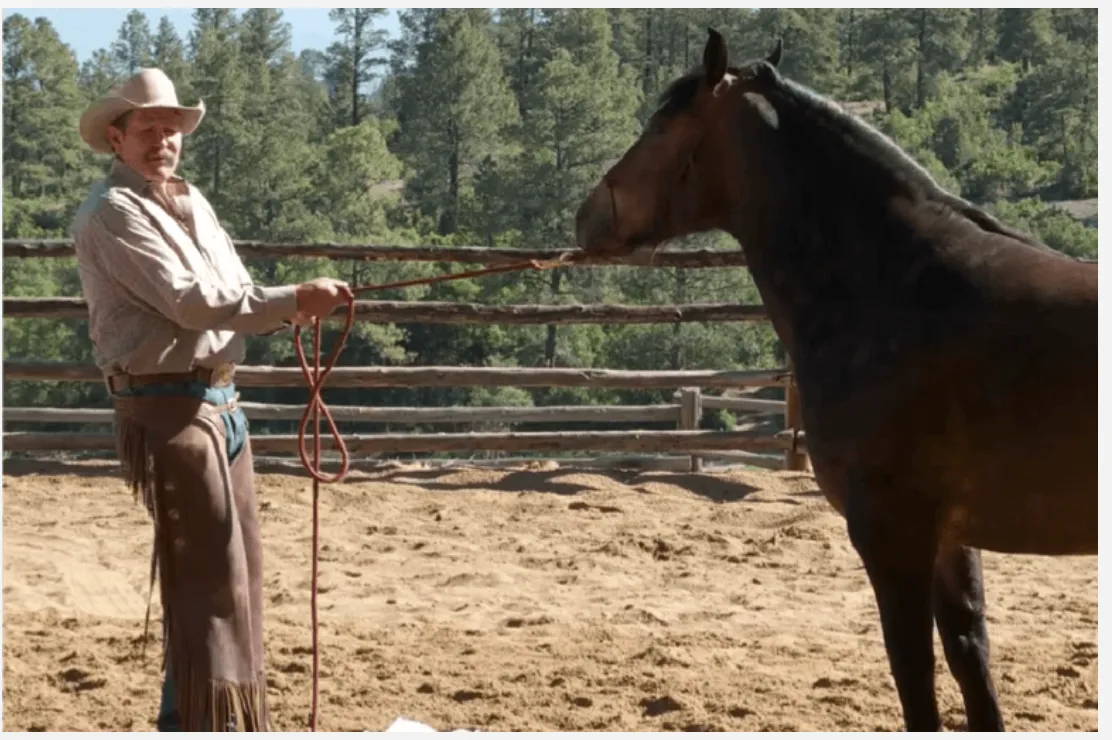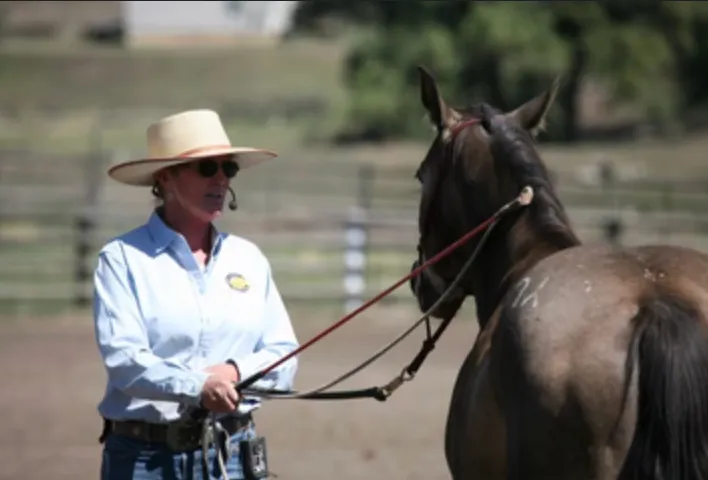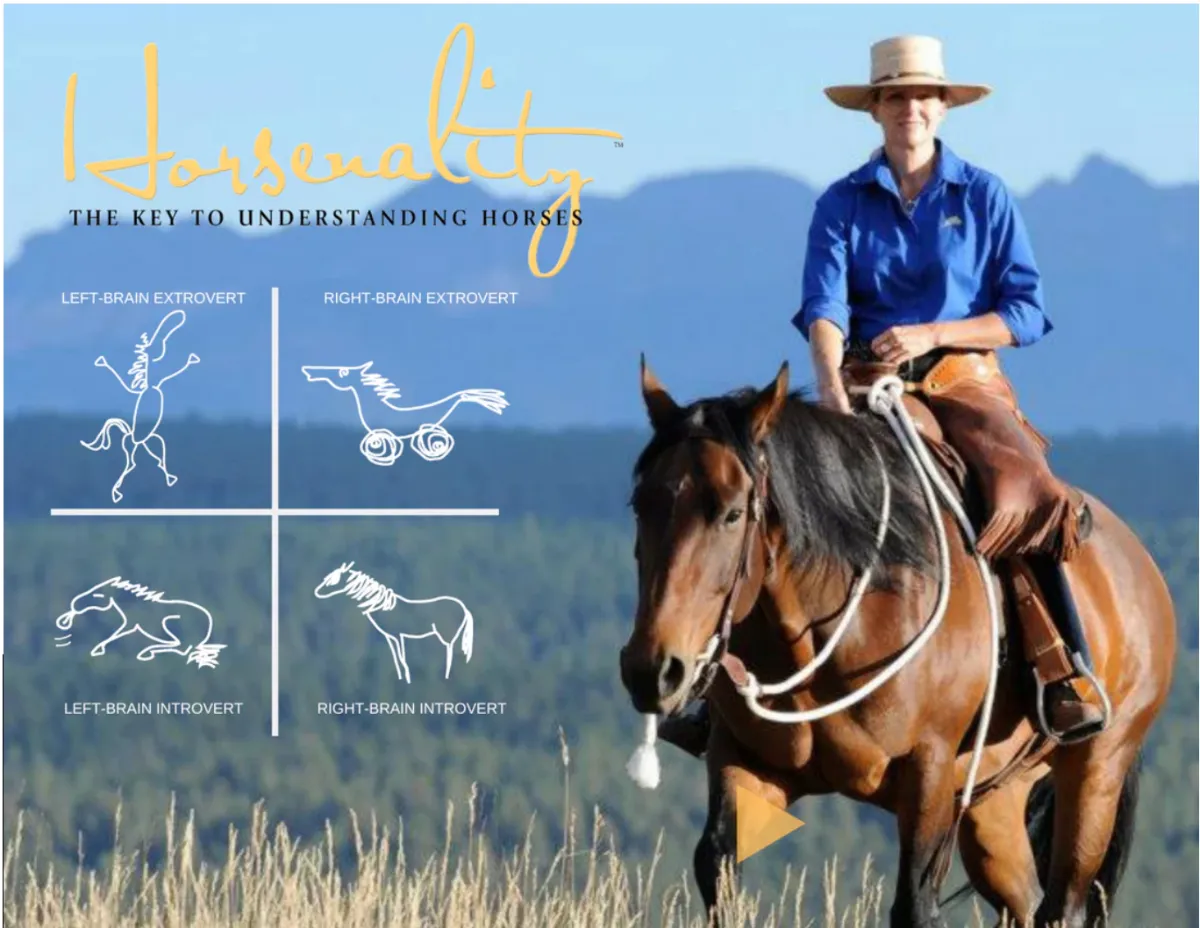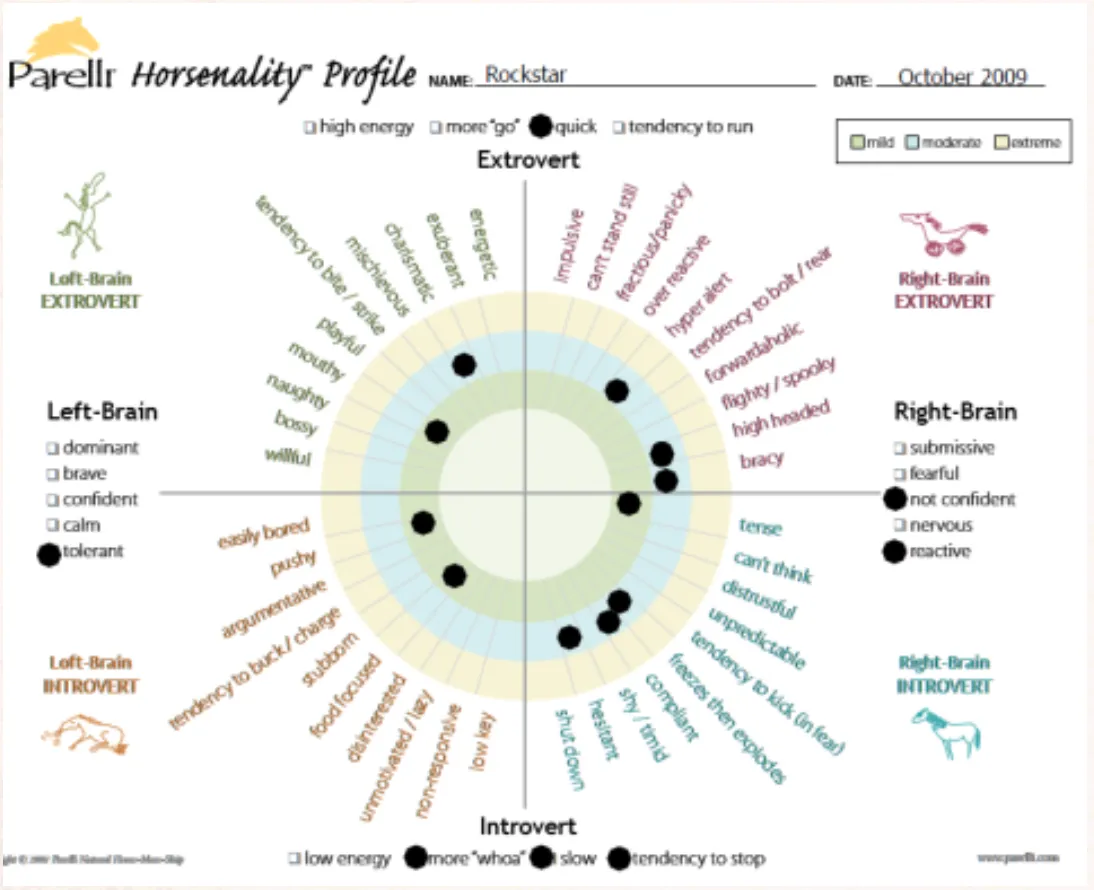Parelli Natural Horsemanship: Horsing around with pseudoscience?
Brad MacClure - 14th April 2025
I just got back last week from my third experience riding in the Cavalcade. This year it was held in Twizel and, the same as last year, we rode with the heavy wagons. To clarify, we rode our horses alongside and around a bunch of wagons, carts, and buggies of all shapes and sizes. Part of the deal when you get to ride with the wagons is you should be ready to jump off and assist at times. For example, when a buggy with no brakes had to ascend a steep slope, another person and I had to jump off and be the brakes by hanging onto a rope tied to the back of the buggy. I can feel the anxiety just recalling the memory.
Of course the whole time while riding, (something like 120km total) I was thinking about what I would write next for the NZ Skeptics Newsletter… Just kidding, no I’ve had this topic on my mind for a long time actually.

Years ago I was introduced to Parelli Natural Horsemanship (PNH), a structured system which promises a deeper connection between horse and rider using “natural” techniques. PNH is one of the most well-known horse training programs in the world. Developed by Pat Parelli in the 1980s, the system has gotten a cult-like following, with enthusiasts swearing by its principles of communication, psychology, and leadership. However, PNH has also attracted criticism from experienced horse trainers, equestrians, and animal behaviorists.
I noticed a few things right away which gave me pause. One was that some of the people who were into it seemed to also be into various other woo-woo. Okay, that of course doesn’t mean it’s necessarily nonsense. It just means that you can’t really verify that that person arrived at this system through sound epistemology. Secondly, as I say, it’s quite cult-like. You notice straight away that they kind of have their own language, and some of them also idolise Pat Parelli, just a bit. Thirdly…capitalism, baby! It always comes down to “give me money”. To do all 4 “levels” of their online program costs $999USD (more if you do it in increments). You can do “on campus” courses, which are $2,500 for 5 days, $7,500 for a month, and $12,000 for 10 weeks. Everything is expensive through PNH, and they sell a lot of horse stuff which you could buy elsewhere more cheaply. They’ll tell you why their products are better, but it’s mostly hype. Of course, none of those things actually mean PNH is bad. I mean, it could be a truly innovative way to work with horses… or it could be an overhyped marketing scheme that prioritises profit over practical horsemanship. So, let’s delve into some of what it’s about.
The concept of Natural Horsemanship
Skeptics will have already noticed the word “natural” in there. It may have sparked alarm bells because we skeptics are primed to look out for the naturalistic fallacy. To be fair, that’s not really what this is (I mean, there’s also the “fallacy fallacy”, dismissing a thing that could legit because you see a fallacy in its presentation). I do think it’s fair, though, to say that to some extent PNH does cash in on the naturalistic fallacy. People who are susceptible to thinking that “natural” (whatever that means) is always good, will like the idea that “we do natural horsemanship”… as opposed to all that un-natural horsemanship out there. So, yes, as with the naturalistic fallacy, I believe that the thinking which attracts some to natural horsemanship is a true false dichotomy.
The concept of “natural horsemanship” is not new. The idea that a human can communicate with a horse in a way that mimics herd behavior, and fosters a mutual understanding, goes way back (there are documented instances as far back as the two part treatise On Horsemanship by Xenophon, circa 430 – 354 BCE). The modern natural horsemanship movement is substantial too, and seems to have started in the USA with the likes of brothers Tom and Bill Dorrance, Ray Hunt, and Buck Brannaman. Those men are the pioneers of the movement, though I don’t think they saw themselves as starting a movement. Monty Roberts and Pat Parelli came later, along with the marketing (and monetising) of the ideas, and the coining of the term “natural horsemanship” by Parelli in the early eighties.
The Effectiveness of PNH
PNH promises that, through groundwork exercises and a structured program, even a novice horse owner can build a trusting relationship with their horse without the need for traditional force-based training methods. It’s the most structured system I know of, which is in my opinion not a bad thing. As we all know, it’s often a good structure that achieves results. Even if the system itself isn’t efficacious, the structure can simply make us take the time to do what’s required. A sunk cost fallacy might come into it here too. You pay all that money, you’re damn well going to make it work - or at least persuade yourself that it works.
This is where the whole system reminds me of MLMs and the supplement industry. There’s also an “Emperor’s New Clothes” sort of feel, where peer pressure can tend to make you feel like you’re the problem if you don’t achieve within the system. I subscribed to the basic system for a little while many years ago, and have also done a few clinics with Parelli instructors. The clinics were good, and I have learned some really good stuff from them, but I have to say that everything - the clinics, but more so the online videos and such, are padded out with so much unnecessary stuff. Pseudo-philosophical stuff, some of it just common sense dressed up as platitudinal profundity. Pat Parelli is the Jordan Peterson of horse training! I’d say a twenty minute session could be boiled down to about two minutes.
It’s also mostly stuff you would get for free from many experienced horse people. One of the criticisms of PNH is that it somewhat lacks a solid foundation in equine science and practical training principles. While the system emphasises reading a horse’s body language and responding accordingly, the practical application of these ideas can sometimes be vague.

Seven Games
As an example of the structure I mentioned above, Parelli has a series of exercises called “The Seven Games”. Each game focuses on specific ways a horse would normally communicate and respond in a herd, or sometimes in regard to a predator approaching in the wild. So the games are supposedly using these responses as a kind of language. When you get into it, some of this can be quite good fun actually. It becomes like a whole vocabulary of communicative devices. Horses are prey animals, and they are always reading the situation with their own safety in mind. So some of these games are based on that idea. You turn what would be herd behaviour into a way of communicating. A few examples are:
Friendly Game: Throw your rope over your horse’s back, around his legs, his neck, etc. staying very calm and non aggressive while you do it. It’s just like another horse flicking him with its tail. This can desensitise the horse to things he shouldn’t be worried about too, like ropes flying around. If he’s not used to it, he’ll move a bit. You keep doing it until he realises it’s not a threat, and he stops moving. I still do this quite a lot with my horses. I’ve also seen other cowboys do it who aren’t “Parelli” trained, so it’s a good example of a thing that they’ve systematised and given a name, as if it’s their invention.
Porcupine Game: This game teaches the horse to yield to steady pressure. You apply light pressure with a rope or your body, and encourage the horse to move away from that pressure. The trick is to stop as soon as you get the right response, stopping the pressure is the reward.
Driving Game: In this game, the pressure is rhythmic, like tapping. It helps the horse learn to move away from you when you need him to.
Yo-yo Game: teaching the horse to back up and come back to you, just by holding the rope and moving it a certain way.

You get the idea. One of my biggest issues with PNH is, as I alluded to, I feel like they pretend that they came up with these ideas, when actually they just managed to monetise them. Which is fine I guess, as long as there’s no harm.
So, shall I get to the point? Is there harm? The short answer is maybe. I’ve heard horse people of the non PNH variety talk about this or that horse who was “ruined by Parelli”. Reddit and equine forums are full of opinions about it, some of them claiming to have had really bad experiences. Reading through them, and between the lines, so to speak, I get the impression that his methods don’t always translate well to less experienced people. I found that you can easily get things wrong, just by bad timing or being a bit clunky with your movement. And it takes a lot of time!
Parelli’s system is largely geared toward those less experienced horse owners who may not have the experience to correctly interpret horse behavior or apply techniques with the necessary nuance. This can lead to situations where horses become resistant, fearful, or even aggressive due to inconsistent handling, so the literal opposite of what you want! Some professional trainers argue that traditional, well-established training methods grounded in operant conditioning, and positive reinforcement are more effective than Parelli’s approach. I found an academically written and well referenced article by Alice Campbell here that is quite critical of Pat Parelli’s methods. If you’re interested in more details, you should read her article in full. I’ll summarise the main points she makes here:
- Pat Parelli promotes the equipment he designed as essential (there’s even a range of stuff called “essential”). He fosters the idea that you must use his equipment to succeed. Of course it’s pricey, and worse, it may even be bad to use some of it, methodologically. For example there are criticisms about the rope halter, and a whip-like thing called a “carrot stick”.
- Parelli’s use of anthropomorphic language with regard to horses is problematic, and “may cause false beliefs that result in unrealistic aspirations, and misinterpretation of equine behaviour”…”very little is known about what emotions horses can feel and whether they can experience love or happiness like we do. Therefore, making assumptions about how the horse thinks is unrealistic and could lead to inappropriate training methods”.
- Further to that last point, “Dominance and Leadership” is a key concept of PNH. “This theory involves the idea that mutual respect is necessary for good training and to gain a relationship with horses. It comes from the observation that horses create hierarchies within the herd and the belief that trainers should act similarly to how horses act in their natural groups…” This makes some assumptions that horses treat us like a member (and a leader, hopefully) of their herd. There is no good evidence for this, and the false assumption may be counterproductive.
- PNH focuses a lot on the use of negative reinforcement, and there are studies which show that the use of negative reinforcement during training can increase stress.
You can see that Campbell’s criticisms are a tad more objective than mine. Also honestly, I’m not 100% convinced that some of the things she’s concerned about are 100% bad. However she does touch on the aspect that bugs me the most: the deceptive marketing and the cost, which I will get to a little later. With regard to her criticism that PNH encourages the anthropomorphising of horses and their emotional states etc. This brings us to my biggest irritation.
What’s your Horsenality?
One of the interesting and probably unique features of PNH is the “Horsenality” report. This is off their website:
Horsenality® is the term that Pat Parelli coined to refer to understanding horses through their basic personality types. A combination of the words “horse” and “personality,” Horsenality® is a convenient way to talk about horse behavior in conjunction with the Parelli Natural Horsemanship method.
One of the goals of the Parelli program is to help horse owners understand their horse’s individual personality and to educate people about how to teach their horses in the ways that are most effective for each personality type.
The Horsenality® system helps students quickly identify a horse’s innate character. Students can then create instant rapport and achieve great results by knowing what’s uniquely important to that individual horse. This approach to understanding horses helps horses — and their owners — become more balanced, centered and confident.

Although it says above that Pat Parelli coined the term “horsenality”, it turns out Linda, Pat’s aussie wife, developed the system, inspired by a kinesiologist, author and all round pseudoscience enthusiast named Glynn Braddy. As I understand it, you send in details about your horse, maybe a video, fill in a questionnaire, pay $49 USD and you’ll get a report back which you may or may not find helpful depending on your level of gullibility.
If you look at the image above, you’ll see that, in simplest terms, the four basic categories of horsenality are:
- right-brained extrovert (high fear / high energy);
- right-brained introvert (high fear / low energy);
- left-brained introvert (high dominance / low energy); and
- left-brained extrovert (high dominance / high energy).
The report you get back will be way more dressed up than just which of the four categories your horse fits; there are gradients in between, and so on, but that’s about it. Below is a chart I pulled off Pinterest. I believe this is the actual thing you get back, and this is one someone put online to show.

You will have noticed the use of “left brain/right brain” terms, perpetuating the long debunked idea that different dominant sides of the brain skew personalities… horsenalities, if you will… different ways. I realise that to some extent this is just a framing, and doesn’t necessarily have to reflect a belief in the actual brain nonsense. I would ask why use that framing at all if you know it’s bunk? I suspect they don’t.
“Horsenality”, of course, is supposed to be a portmanteau of horse and personality. Aside from being the dumbest and most irritating portmanteau I’ve ever seen, it also makes no sense. A personality is about a person, so then is a horsenality about a horsen? Yeah, that isn’t a thing. But Pat Parelli is all about silly words and sayings. Did you notice his name is alliterative? He uses that too, in his videos he says stuff like “Pat Parelli’s prior preparation and proper presentation prevents purposeful perpetuation of problems…” and so on. It’s very annoying, but I digress!
All experienced horse trainers and clinicians I’ve ever spoken to, except for Parelli instructors of course, say this “horsenality” thing is basically useless. They point out that, depending on factors like environment and circumstance, your horse could exhibit all four “horsenalities” in the space of an hour. Yes, horses do have different personalities, for sure, and some find certain tasks harder, while some are better at different things. But this system is implying that you need different techniques for different horses… oh sorry, horsenalities. I would argue that you should have all the tools in your tool box, and be sensitive to how your horse is in the moment. Learn to watch the signs he gives you. It’s another way they have tried to systematise and monetise an idea which was inspired by pseudoscience in the first place.
The Marketing Machine and the cult
Speaking of monetising, I’ve alluded a few times already to the highly commercialised nature of PNH. It’s always reminded me of multi-level marketing companies, with different levels of training, certifications, and an array of branded products that are often priced significantly higher than similar non-branded alternatives. I have to admit, too, that there’s a certain cultiness to the PNH community. When you get introduced to it there’s that type of enthusiasm which has that vibe many will be familiar with. It’s like they’re a little too fanatical and brand-oriented, and Pat & Linda Parelli seem to have a guru-like status.
Conclusion
Horsemanship is not a one-size-fits-all discipline, and while some principles of Parelli’s system may be useful in certain contexts, the program’s rigid structure and heavy commercialisation raise doubts about its legitimacy as a superior training method. Also I honestly believe that they don’t offer anything you can’t learn from other good clinicians. In-person clinics with experienced instructors are much safer, and you’re more likely to take home valuable skills because the instructor is able to watch you and give immediate feedback.
While Parelli Natural Horsemanship has undoubtedly introduced many people to the idea of working with horses in a less forceful way, its effectiveness remains highly questionable. Just like religion, the good things in that community are available elsewhere, at a much lower cost! The marketing side of it makes me cringe. Its vague and sometimes contradictory training principles, the fact that it can potentially mislead inexperienced horse owners, and that they use pseudo-scientific ideas and terms which lack value, all arouses my skepticism, and It seems much of the equestrian community agrees.
Ultimately, good horsemanship is about understanding the individual horse and applying techniques that are rooted in science, experience, and compassion — not just blindly following a brand-name training program. Before investing time and money into Parelli’s system, horse owners would be wise to explore a range of training methods and seek guidance from reputable trainers who prioritise the horse’s well-being over commercial success.